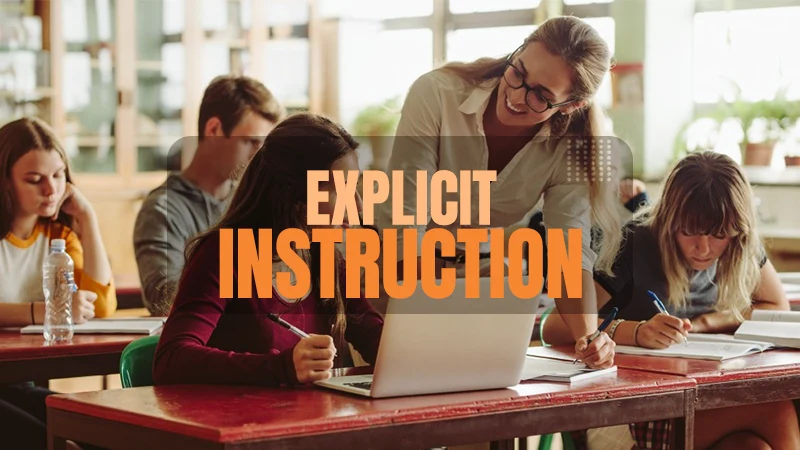
We all find it easier to follow direct instructions. They are simple to understand as they express everything clearly. Implied facts create a lot of confusion and can cause errors as we have to assume a lot of things.
Explicit instruction adopts the same idea of presenting information in a direct and sorted manner. It is a practical and systematic method that delivers details in a clear-cut style.
Explicit learning is also called teacher-directed learning, as this personally conveys the educator’s understanding directly to the students. This article will explore all the components of explicit teaching and learning. Check out the table of contents, which gives an overview of the scope of the article.
When there is a whole bunch of facts we need to remember, we try to divide the huge task into easily comprehensible batches. Then we move on with a step-by-step learning approach.
Explicit learning adopts this formula to ease up the learning process. This strategic system of learning is not only helpful for kids facing literacy struggles but also for everyone. This method can be combined with a lot of other reading programs, such as the Orton Gillingham Reading Program. In order to reap the benefits of the approach, we need to understand how it works. So let us begin.
What is Explicit Instruction?
Explicit Instruction refers to a style of presenting information in a way that all the facts are stated clearly. It works on building the knowledge base of students and prepares them for further learning.
It is based on the belief that every student can learn and that every educator is capable of excellent teaching if trained properly. Furthermore, it acknowledges and applies to all learning styles. Thus encouraging a universal design for learning.
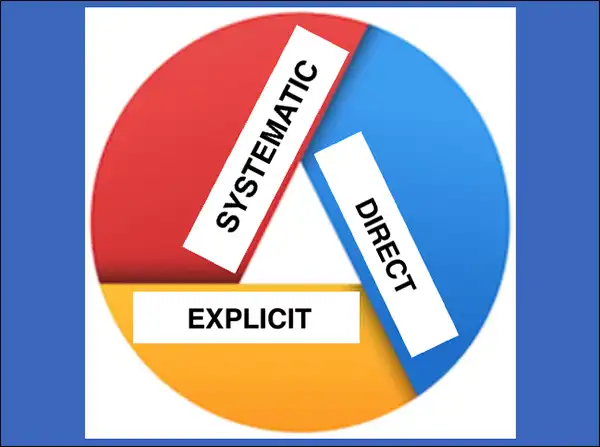
Explicit teaching has many different aspects and points to cover.
They are:
- Displaying content in a way that the writing and the content are valued and are defined in a way that is easily understandable and enjoyable to read.
- Writing should be done in a manner that none of the points remain unexplained. All facts and data should be clear-cut, and nothing should be left to the imagination.
- The context of each topic should be practically explained in a way that the students can relate to it. All work should be done with a clear connection to prior learning so that students understand the concepts from the base level.
- Linking new knowledge to prior knowledge makes it easier to retain information.
- The concepts of the topic or the task in hand must have a clear purpose in the mind of the students. Every student must know and understand why they are studying what they are learning.
- Presenting and explaining the nature of the tasks with clarity and then explaining the procedure in a way that hints at their completion.
- Offering clear demonstrations or examples of what is being taught and what should be the end goal of the learning.
- Students should be taught what their teaching and learning will look like in real life. Explicit instruction can also be conveyed through the practical application of knowledge, more like following a kinesthetic learning style.
- Students should be well-informed about what is the scope of their learning and how they should demonstrate what they have learned.
Carolyn Meritt, the Vice-chair of Code Red Dyslexia Network, said, “If you surround a child with water, do they magically learn to swim without explicit instructions? No- they drown-much like our dyslexics drowning in a sea of words.” This is what explicit instructions aim to resolve.
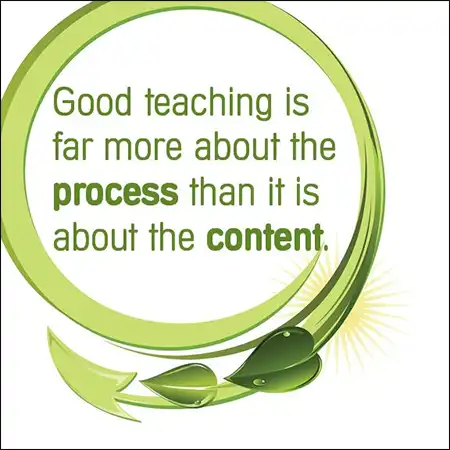
Explicit teaching or learning can also be treated as a direct way of learning. This form of learning was first developed through various studies done in the 1960s and 1970s. It was developed by Siegfried Engelmann and Wesley C. Becker.
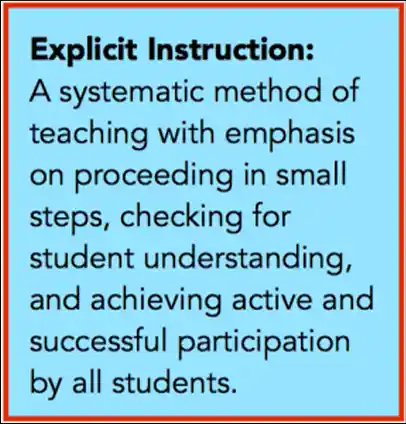
Direct Instruction teaches an explicit way of learning, rather than the traditional format of inquiry-based learning. The students don’t have to question anything as all information is presented upfront.
It is mainly helpful for people with learning disorders as they ease the learning process. Together with a step-by-step approach, explicit learning lays down facts to avoid even the slightest confusion.
There are certain fundamental components of the explicit learning methodology. These are essential and can be called the pillars of the explicit teaching.
The Five Components of Explicit Instruction
Explicit learning, also known as direct instruction or learning, is proven to be better at teaching than other methods. The reason behind this could be how the facts are laid out clearly, avoiding any confusion. This induces faster and more in-depth learning.
There are 5 inherent and essential components of explicit instruction. These phases define how this approach proceeds with the teaching process. These phases are:
- Direct Explanation
- Modeling
- Guided Practice
- Verification
- Application
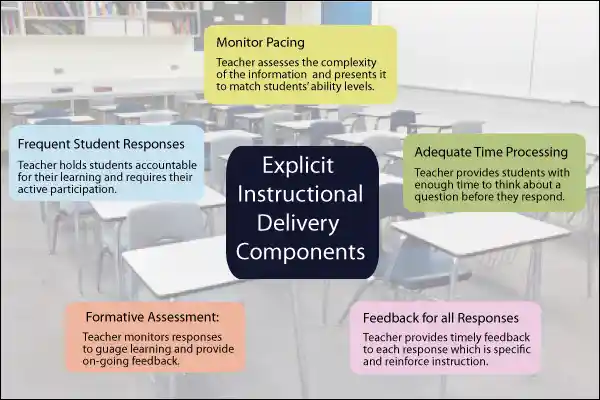
Each of these phases handles a distinct part of the curriculum and collectively achieves the goal of literacy. Proficiency in one phase lays the foundation for the next phase.
Let us now understand each of these phases thoroughly and the subsequent tasks that help achieve the objective of each phase.
Direct Explanation
As the name suggests, teachers explain the topic. The explanation is done in a way that the new facts are related to the prior knowledge of the students. For instance, if they are learning about the laws related to gravity, they will first be asked to demonstrate their knowledge about gravity.

In this stage, the educator asks a lot of questions at the beginning to understand the progress of the students. It is also necessary to provide practical examples to paint a perfect mental picture of the event. This helps in having an extensive cognition of the topic or subject.
Activities that the educator can explore to teach better are:
- Giving hints and connecting to already-known facts.
- Including questions that are common to the topic.
- Videos to demonstrate the topic better.
- Using labeled pictures that explain the facts in the form of a story.
Modeling
This stage is based on the educator’s interaction with the topic. The teacher must reveal their own observation about the events. That’s why this phase is also called the “I Do It” stage. This encourages students to have their own perception of the concepts.
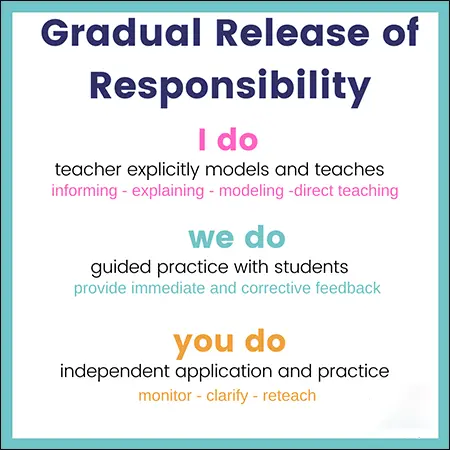
Students should be asked to think and also keep track of their thought processes and conclusions. This way, the educator can survey the progress of the student and detect and sort out any misunderstandings.
Activities that aid educators in teaching in this phase are:
- Reciting their observations by thinking out loud.
- Pausing for a couple of minutes after each fact to give students time to think.
- Defining the base concepts thoroughly and sometimes repetitively.
- Include Kagan Strategies: Motivate the students to engage in group discussion and communicate their observations. This exchange of ideas will open their minds to new possibilities.
- Supporting the students through verbal discussions, creating small groups with students of different personalities, etc.
Guided Practice
This phase is alternately called the “We Do It” stage. Here the students work through to illustrate what they have learned. They can design and carry out our experiments; they can author research articles, can build questionnaires based on their knowledge, etc.
The educators can provide the students with ideas. However, that is where the teacher support ends, and the students are left to utilize their own imagination and skills. This stage contributes to the cognitive and mental development of the students.
Activities to be utilized at this phase are:
- Adhering to the assignments prepared by the students to assess their progress.
- Encouraging them to rewrite the concepts or stories and highlight their queries.
- Teaching the students the importance of bookmarks.
Verification
This phase needs the educators to provide feedback to the students and suggest corrections in the necessary places. Teachers not only pinpoint errors but also explain the reasons behind them.
Activities relevant to this phase are:
- The student notes are to be verified.
- Using methodologies that motivate students to interact with their peers and compare their own notes and strategies.
- Illustrative representation of the concepts so that the students can draw conclusions through the steps.
Application
The “You Do It” stage. Now that the students have an exhaustive comprehension of their curriculum, they have to start reflecting and utilizing their knowledge on their own. They can use procedures to demonstrate their learning. It can be in a written format, through a speech, a visual representation, or a combination of all.
Activities regarding this stage are:
- Avoiding any teacher intervention. However, the educator is still supervising the student undertakings to understand the student preferences and use this knowledge in further teachings.
- Students should be motivated to find their own faults and correct them, ensuring self-reflecting habits in them.
- Encouragement for peer discussions to learn from their classmates. This teaches the student’s sportsman spirit and collaborative attitude.

Explicit learning follows the aforementioned sequence of 5 phases to impart knowledge to students. The five stages provide room for practice and precision, thus bestowing students with expertise in the concepts.
This program is the most beneficial for dyslexic children. It simplifies how the curriculum is presented to them without burdening their cognitive abilities. The approach is focused on removing confusion and ensuring success. Explicit instruction has some native elements. Let’s get to know about them.
The 16 Elements of Explicit Teaching
Explicit teaching is more about “how to teach”. The building blocks of this teaching procedure handle knowledge in an organized manner. There are 16 elements of explicit teaching which edify educators about the art of teaching.
“Effective and efficient instruction requires that we attend to the details of instruction because the details do make a significant difference in providing quality instruction that promotes growth and success.”
- Anita Archer & Charles Hughes in Explicit Instruction
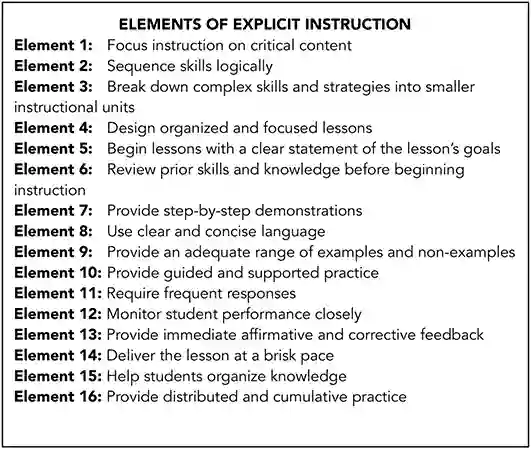
The observations of Anita Archer and Charles Hughes have taught the world about the explicit teaching procedure. Even though the method was in practice for a long time, it was still not popular enough. Archer and Hughes enlightened the world about it. They have mentioned these 16 elements of the approach to help teachers adopt it. Let us now get to learn these:
- Focus instruction on critical content: Critical content refers to the basic knowledge that is required to understand facts further in life. Teaching primary skills, ideas, and rules should be the first step.
- Sequence skills logically: Following the rational advent from easy to hard. Teachers should introduce simple concepts first and build up the knowledge to handle complex topics. Also, the common preference should be going from common skills to the occasional ones.
- Break down complex skills into smaller steps: This is the most talked about feature and advantage of the explicit teaching strategy. Lessons are divided into tiny instructional segments and taught step-by-step.
- Design organized and focused lessons: Remove any unimportant parts in the lesson and sort topics in a way to convey only the requisite facts.
- Set the expectation to start the lesson: Inform the students beforehand what their schedule will look like. A clear picture avoids any unnecessary surprises and students feel relaxed and prepared.
- Review prior skills: Explicit teaching builds new knowledge by linking it to previous learning. Hence, it is important to evaluate a student’s prior knowledge bank.
- Demonstrate stepwise instructions: In this approach, thinking and experimenting go hand in hand. Demonstrations and illustrations are an inevitable part of the explicit learning journey.
- Use clear and concise language: When the entire methodology works to remove ambiguity, it goes without saying that educators must use simple and understandable language.
- Provide examples and non-examples: Teachers must try to define scenarios that students may encounter. This involves providing instances where a skill should be used or avoided.
- Provide students with guided practice: Teachers have to help students with undivided attention and regular support when introducing them to a new concept.
- Require frequent responses: Regular interaction with teachers, encourages the student to ask for help in resolving queries. Student-teacher discussions are an integral part of explicit teaching.
- Monitor student performance closely: A student’s performance and knowledge are regularly tracked by the teachers. This helps in filling any gaps in their skill set and reducing mistakes.
- Provide immediate feedback: Enhancing the understanding and performance of students depends upon the review of the mentor. The feedback of the educator should be quick, affirmative, and corrective.
- Deliver instruction at a brisk pace: Lessons should be presented at an acceptable speed, avoiding unnecessary dilly-dallying.
- Connect information across lessons and context: Explicit teaching exhibits how concepts fit together. The educators work on imparting knowledge in a way that links all skills more evidently.
- Provide abundant time for practice and cumulative review: The repeated practice of any skill helps in mastering it. In explicit learning, students are offered numerous possibilities where they can utilize their past and new skills multiple times. This helps retain information better and thus builds expertise.
The approach can be better comprehended with help of a lesson plan. We will now define a classroom outline of how the educator can employ explicit teaching in the learning process.
How is Explicit Learning Applied?
As this approach to teaching and learning is greatly helpful to students with various learning disabilities, it includes planned strategies. There are mainly three strategies:
- Preparing the lesson: First, the teacher has to be clear on what exactly they want to teach. Basic concepts are termed “Critical Concepts” and are taught first. The critical concepts require the most amount of explicit instructions to ensure their thorough understanding.
The complicated data is broken down into smaller facts and taught sequentially. Here, it is important for the educator to break down the intricate facts in a way that is simplified enough to be understood.
- Beginning the lesson: After the content is decided, it is time to start the session. Before starting with the actual lesson, the students should be provided with the planning of the lesson. This way, students will have an insight into what the lesson is going to be about.
- Delivering the lesson: This begins with showcasing the knowledge that the students will gain. Followed by supervised practice, where the teacher helps the students master the skills. Finally, the students are asked to apply their knowledge without any help.
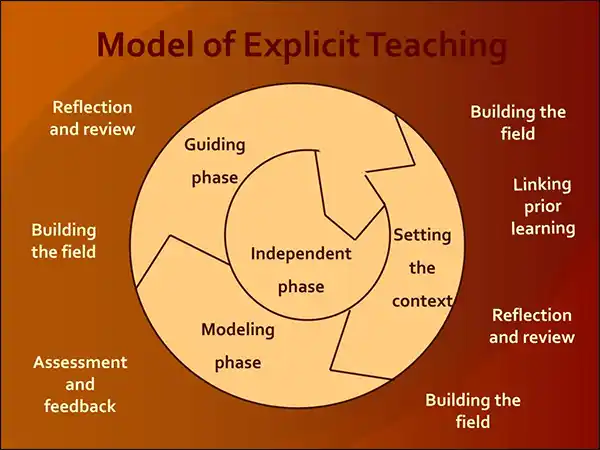
Explicit instructions believe in building new knowledge on the basis of preliminary knowledge. Even though it is criticized by many, it is undeniable that this method also has meticulous research to back it up. There are certainly many benefits to this direct approach to instructions.
Benefits of Explicit Instructions
Another name for explicit learning is “fully guided learning.” It is because every lesson, every fact, and even pronunciation lessons are explained in detail. Owing to this fact, many take explicit learning as a form of rote learning, thinking that the teacher might be standing in the class dictating facts. Contrary to this, explicit teaching and learning actually have a very engaging outlook.

Let us list down all the benefits of this kind of learning:
- Activates students’ previous knowledge.
- Students learn through step-by-step guides, thus avoiding any cognitive load.
- Teachers can detect and correct mistakes in the earliest stage, therefore avoiding any accumulation or ripple effect of errors.
- Educators provide detailed guidelines and also end the lesson with elaborative feedback.
- The curriculum can also be customized based on the student’s understanding level. This offers room for improvement.
- Independent practicing opportunities so that students can apply what they have learned.
- The freedom to have their own thought process to draw conclusions. This allows the students to retain the information better as they have a hands-on learning experience with it.
- Regular evaluation allows educators to know what the students have learned.
Final Thoughts
Explicit learning is rightfully called evidence-based learning. Students are practically offered instances that give them a pragmatic view of the concepts they are learning. This type of structured literacy helps students with dyslexia who have a hard time grasping common concepts. When the information is molded in a way that reaches students in their preferred learning style, teaching yields better results. And that is the end goal of teaching. Irrespective of subjects or students’ abilities, teaching aims to impart knowledge.
Sources:


